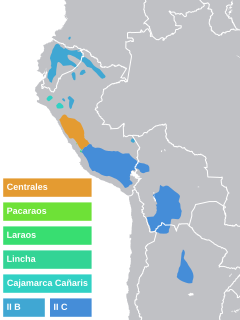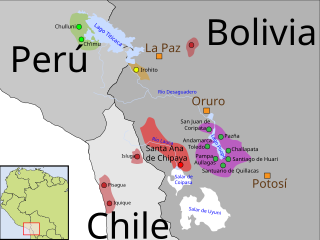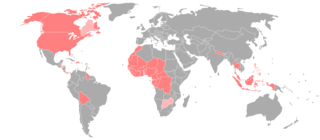 W
WAymara is an Aymaran language spoken by the Aymara people of the Bolivian Andes. It is one of only a handful of Native American languages with over one million speakers. Aymara, along with Spanish, is an official language in Bolivia and Peru. It is also spoken, to a much lesser extent, by some communities in northern Chile, where it is a recognized minority language.
 W
WCanichana, or Canesi, Joaquiniano, is a possible language isolate of Bolivia. In 1991 there were 500 Canichana people, but only 20 spoke the Canichana language; by 2000 the ethnic population was 583, but the language had no L1 speakers left.
 W
WThe Chapacuran languages are a nearly extinct Native American language family of South America. There are three living Chapacuran languages which are spoken in Rondônia in the southern Amazon Basin of Brazil and in northern Bolivia.
 W
WGuaraní, specifically the primary variety known as Paraguayan Guarani, is a South American language that belongs to the Tupi–Guarani family of the Tupian languages. It is one of the official languages of Paraguay, where it is spoken by the majority of the population, and where half of the rural population is monolingual. It is spoken by communities in neighboring countries, including parts of northeastern Argentina, southeastern Bolivia and southwestern Brazil, and is a second official language of the Argentine province of Corrientes since 2004; it is also an official language of Mercosur.
 W
WPanoan is a family of languages spoken in Peru, western Brazil, and Bolivia. It is possibly a branch of a larger Pano–Tacanan family.
 W
WPuquina is a small, putative language family, often portrayed as a language isolate, which consists of the extinct Puquina language and Kallawaya, although it is assumed that the latter is just a remnant of the former mixed with Quechuan. The Qhapaq simi, which was spoken by the Inca elite, in contrast to the Quechuan-speaking commoners, is thought to be related, as well as the Leco isolate language. They are spoken by several native ethnic groups in the region surrounding Lake Titicaca and in the north of Chile. Puquina itself is often associated with the culture that built Tiwanaku.
 W
WSouthern Quechua, or simply Quechua, is the most widely spoken of the major regional groupings of mutually intelligible dialects within the Quechua language family, with about 6.9 million speakers. It is also the most widely spoken indigenous language in the Americas. The term Southern Quechua refers to the Quechuan varieties spoken in regions of the Andes south of a line roughly east–west between the cities of Huancayo and Huancavelica in central Peru. It includes the Quechua varieties spoken in the regions of Ayacucho, Cusco and Puno in Peru, in much of Bolivia and parts of north-west Argentina. The most widely spoken varieties are Cusco, Ayacucho, Puno (Collao), and South Bolivian.
 W
WSouth Bolivian Quechua, also known as Central Bolivian Quechua, is a dialect of Southern Quechua spoken in Bolivia and adjacent areas of Argentina, where it is also known as Colla. It is not to be confused with North Bolivian Quechua, which is spoken on the northern Andean slopes of Bolivia and is phonologically distinct from the South Bolivian variety. Estimates of the number of speakers of South Bolivian Quechua range from 2.3 to 2.8 million, making it the most spoken indigenous language in Bolivia, just slightly greater than Aymara, with roughly 2 million speakers in Bolivia. In comparison, the North Bolivian dialect has roughly 116,000 speakers.
 W
WSpanish is a Romance language that originated in the Iberian Peninsula of Europe. Today, it is a global language with nearly 500 million native speakers, mainly in the Americas and Spain. It is the world's second-most spoken native language after Mandarin Chinese, and the world's fourth-most spoken language overall after English, Mandarin Chinese, and Hindi.
 W
WTacanan is a family of languages spoken in Bolivia, with Ese’ejja also spoken in Peru. It may be related to the Panoan languages. Many of the languages are endangered.
 W
WThe Uru–Chipaya family is an indigenous language family of Bolivia.
 W
WAmerican Sign Language (ASL) developed in the United States and Canada, but has spread around the world. Local varieties have developed in many countries, but there is little research on which should be considered dialects of ASL and which have diverged to the point of being distinct languages.